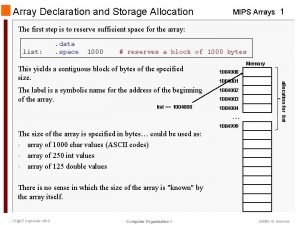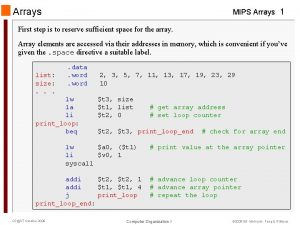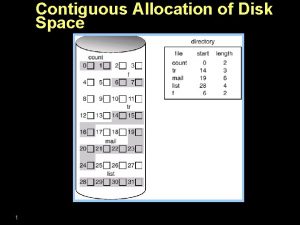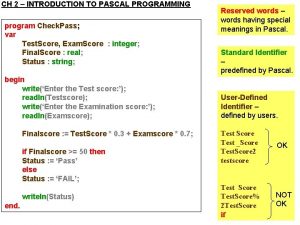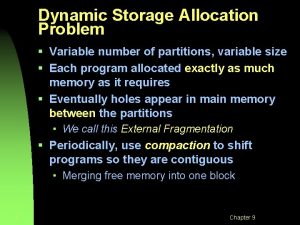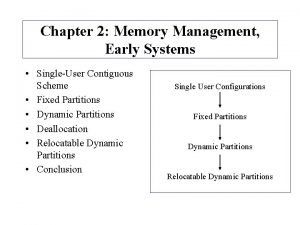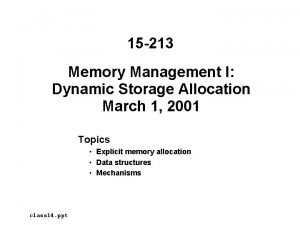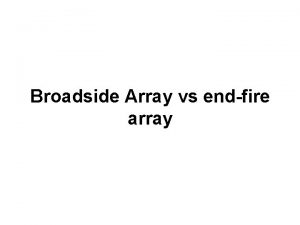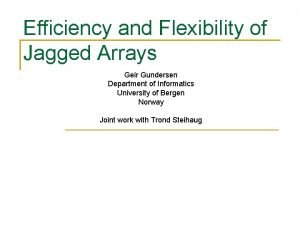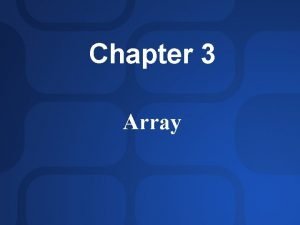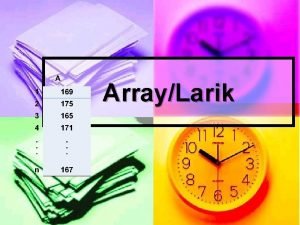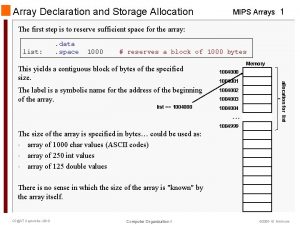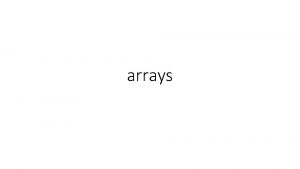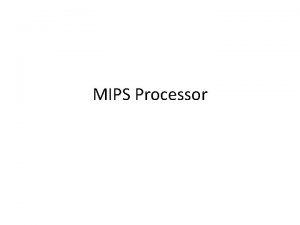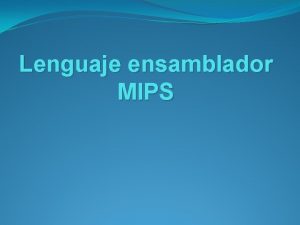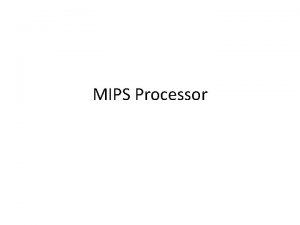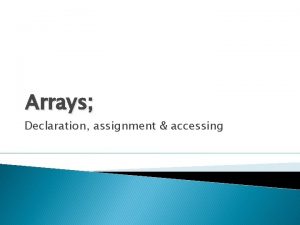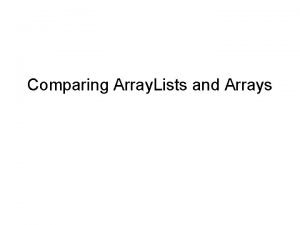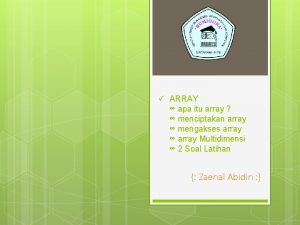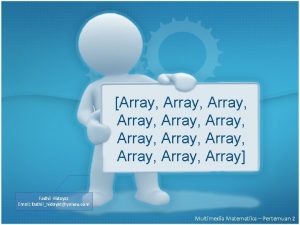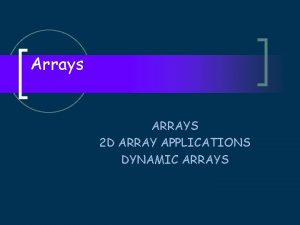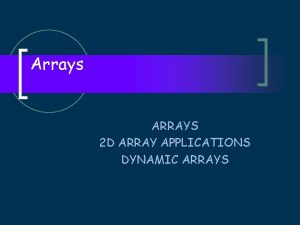Array Declaration and Storage Allocation MIPS Arrays 1


















- Slides: 18

Array Declaration and Storage Allocation MIPS Arrays 1 The first step is to reserve sufficient space for the array: list: . data. space 1000 # reserves a block of 1000 bytes The label is a symbolic name for the address of the beginning of the array. list == 1004000 Memory 1004000 1004001 1004002 1004003 1004004. . . allocation for list This yields a contiguous block of bytes of the specified size. 1004999 The size of the array is specified in bytes… could be used as: • array of 1000 char values (ASCII codes) • array of 250 int values • array of 125 double values There is no sense in which the size of the array is "known" by the array itself. CS@VT September 2010 Computer Organization I © 2006 -10 Mc. Quain,

Array Declaration with Initialization MIPS Arrays 2 An array can also be declared with a list of initializers: . data vowels: . byte pow 2: . word 'a', 'e', 'i', 'o', 'u' 1, 2, 4, 8, 16, 32, 64, 128 Address of vowels[k] == vowels + k 1004000 97 1004001 1004002 105 1004003 111 1004004 117 alloc for vowels names a contiguous block of 5 bytes, set to store the given values; each value is stored in a single byte. Memory 1004005 1004006 1004007 1004008 Address of pow 2[k] == pow 2 + 4 * k 1004009 1004010 1 1004012 alloc for pow 2 names a contiguous block of 32 bytes, set to store the given values; each value is stored in a word (4 bytes) 2 CS@VT September 2010 Computer Organization I © 2006 -10 Mc. Quain,

Another View MIPS Arrays 3 69 10040001 10040002 6 F 75 01 00 00 00 02 00 00 00 10040012 65 10040008 61 10040000 Viewed as hex nybbles, the contents of memory would look like (in little-endian): 0110 0001 Note that endian-ness affects the ordering of bytes, not the ordering of the nybbles within a byte. CS@VT September 2010 Computer Organization I © 2006 -10 Mc. Quain,

Array Traversal and Initialization MIPS Arrays 4 Here's an array traversal to initialize a list of integer values: . data list: . space listsz: . word main: 1000 250 . text lw $s 0, listsz la $s 1, list li $t 0, 0 # using as array of integers # $s 0 = array dimension # $s 1 = array address # $t 0 = # elems init'd initlp: beq $t 0, $s 0, initdn sw $s 1, ($s 1) # list[i] = addr of list[i] addi $s 1, 4 # step to next array cell addi $t 0, 1 # count elem just init'd b initlp initdn: li $v 0, 10 syscall QTP: why 4? CS@VT September 2010 Computer Organization I © 2006 -10 Mc. Quain,

Array Traversal Details MIPS Arrays 5 1004008 . . . initlp: beq $t 0, $s 0, initdn sw $s 1, ($s 1) addi $s 1, 4 addi $t 0, 1 b initlp 1004008 1004012 1004016 initdn: 1004020 A variable that stores an address is called a pointer. Here, $s 1 is a pointer to a cell of the array list. We can re-target $s 1 to a different cell by adding an appropriate value to it. CS@VT September 2010 Computer Organization I 1004020 1004024 © 2006 -10 Mc. Quain,

Alternate Traversal Logic MIPS Arrays 6 This traversal uses pointer logic to terminate the loop: . data list: . space listsz: . word main: . text la lw addi sll add 1004008 1000 250 $s 1, $s 0, 1004012 listsz $s 0, -1 $s 0, 2 $s 0, $s 1 1004012 # index of last cell # offset of last cell # ptr to last cell initlp: bgt $s 1, $s 0, initdn sw $s 1, ($s 1) addi $s 1, 4 b initlp initdn: li $v 0, 10 syscall 1004016 . . . 1004996 1004024 QTP: rewrite this using the do-while pattern shown in the previous lecture CS@VT September 2010 Computer Organization I 1005000 © 2006 -10 Mc. Quain,

Array Bounds Issues MIPS Arrays 7 An array can also be declared with a list of initializers: 1004004 'a', 'e', 'i', 'o', 'u' 1, 2, 4, 8, 16, 32, 64, 128 What happens if you access an array with a logically-invalid array index? ? ? contents of address 1004005 1004006 1004007 1004008 1 1004012 2 While vowels[5] does not exist logically as part of the array, it does specify a physical location in memory. . What is actually stored there is, in general, unpredictable. In any case, the value is not one that we want… CS@VT September 2010 Computer Organization I alloc for pow 2 vowels[5] 117 alloc for vowels . data vowels: . byte pow 2: . word Memory 1004036 © 2006 -10 Mc. Quain,

Special Case: Array of Characters MIPS Arrays 8 As we've seen, the declaration: . data vowels: . byte 'a', 'e', 'i', 'o', 'u' Leads to the allocation: 61 65 69 6 F 75 However, the declaration: . data vowels: . asciiz Leads to the allocation: "aeiou" 61 00 An extra byte is allocated and initialized to store 0 x 00, which acts as a marker for the end of the character sequence (i. e. , string). This allows us to write loops to process character strings without knowing the length of the string in advance. CS@VT September 2010 Computer Organization I © 2006 -10 Mc. Quain,

Example: Searching a Character String char: vowels: . data. byte. asciiz MIPS Arrays 9 'u' "aeiou" . text main: srchlp: lb li la lb $t 0, $t 1, $s 0, $s 1, char 0 vowels ($s 0) # # load character to look for it's not found yet set pointer to vowels[0] get vowels[0] beq seq bgt addi lb b $s 1, $zero, srchdn $t 1, $s 1, $t 0 $t 1, $zero, srchdn $s 0, 1 $s 1, ($s 0) srchlp # # # check for terminator compare characters check if found no, step to next vowel load next vowel srchdn: li $v 0, 10 syscall CS@VT September 2010 Computer Organization I © 2006 -10 Mc. Quain,

Example: Setup Details. . . lb li la lb. . . $t 0, $t 1, $s 0, $s 1, char 0 vowels ($s 0) # # MIPS Arrays 10 load character to look for it's not found yet set pointer to vowels[0] get vowels[0] char vowels $t 0 00 00 00 75 $t 1 00 00 61 75 61 65 69 6 F 75 00 $s 1 CS@VT September 2010 Computer Organization I © 2006 -10 Mc. Quain,

Example: Loop Details srchlp: MIPS Arrays 11 . . . beq $s 1, $zero, srchdn # string terminator is 0 x 00 seq $t 1, $s 1, $t 0 # $t 1 = 1 iff $s 1 == $t 0 bgt $t 1, $zero, srchdn # if match found, exit loop addi $s 0, 1 # step to next elem of vowels lb $s 1, ($s 0) # load next elem of vowels b srchlp srchdn: . . . CS@VT September 2010 Computer Organization I © 2006 -10 Mc. Quain,

Example: Print Array Contents list: size: MIPS Arrays 12 . data. word. . . lw la li $t 3, size $t 1, list $t 2, 0 # get array address # set loop counter beq $t 2, $t 3, prndn # check for array end 2, 3, 5, 7, 11, 13, 17, 19, 23, 29 10 prnlp: lw $a 0, ($t 1) li $v 0, 1 syscall # print list element la $a 0, NL li $v 0, 4 syscall # print a newline addi b # advance loop counter # advance array pointer # repeat the loop $t 2, 1 $t 1, 4 prnlp prndn: CS@VT September 2010 Computer Organization I © 2006 -10 Mc. Quain,

Example: syscall Details. . . lw $a 0, ($t 1) li $v 0, 1 syscall. . . la $a 0, NL li $v 0, 4 syscall. . . CS@VT September 2010 MIPS Arrays 13 # syscall #1 prints and integer to stdout # takes value via register $a 0 # takes syscall # via register $v 0 # syscall #4 prints asciiz to stdout # takes address of string via $a 0 # takes syscall # via register $v 0 Computer Organization I © 2006 -10 Mc. Quain,

Example: Palindromes MIPS Arrays 14 A palindrome is a sequence of characters that reads the same from left to right as from right to left: able was i ere i saw elba anna madam It is generally permitted to adjust capitalization, spaces and punctuation: A man, a plan, a canal, Panama! Madam, I'm Adam. For the purpose of an example, we will not allow such manipulations. CS@VT September 2010 Computer Organization I © 2006 -10 Mc. Quain,

Example: Reading a String MIPS Arrays 15 We must reserve space to store the characters: buffer: . space 1025 # 1024 maximum, plus a terminator We'll want to issue a prompt to the user to enter the string to be tested: user_prompt: . asciiz "Enter. . . of no more than 1024 characters. n" We can use a couple of system calls to get the input: main: ## Prompt the user to enter a string: la $a 0, user_prompt li $v 0, 4 syscall ## Read the string, plus a terminator, into the buffer la $a 0, buffer li $a 1, 1024 li $v 0, 8 syscall CS@VT September 2010 Computer Organization I © 2006 -10 Mc. Quain,

Example: Finding the End of the String MIPS Arrays 16 We must locate the end of the string that the user entered: la la Length. Lp: lb beqz addi b Length. Dn: addi $t 1, buffer $t 2, buffer # lower array pointer = array base # start upper pointer at beginning $t 3, ($t 2) $t 3, Length. Dn $t 2, 1 Length. Lp # # $t 2, -2 # move upper pointer back to last char grab the character at upper ptr if $t 3 == 0, we're at the terminator count the character repeat the loop QTP: why -2? CS@VT September 2010 Computer Organization I © 2006 -10 Mc. Quain,

Example: Testing the String MIPS Arrays 17 Now we'll walk the pointers toward the middle of the string, comparing characters as we go: Test. Lp: bge $t 1, $t 2, Yes # if lower pointer >= upper pointer, yes lb lb $t 3, ($t 1) $t 4, ($t 2) # grab the character at lower ptr # grab the character at upper pointer bne $t 3, $t 4, No # if different, it's not a palindrome addi subi $t 1, 1 $t 2, 1 # increment lower ptr # decrement upper ptr b Test. Lp # restart the loop CS@VT September 2010 Computer Organization I © 2006 -10 Mc. Quain,

Example: Reporting Results MIPS Arrays 18 Yes: la $a 0, is_palindrome_msg li $v 0, 4 syscall b exit # print confirmation No: la $a 0, is_not_palindrome_msg li $v 0, 4 syscall CS@VT September 2010 Computer Organization I # print denial © 2006 -10 Mc. Quain,
 Declare array in mips
Declare array in mips Arrays mips
Arrays mips Array of arrays c++
Array of arrays c++ Contiguous allocation vs linked allocation
Contiguous allocation vs linked allocation Pascal array declaration
Pascal array declaration Dynamic storage allocation problem in os
Dynamic storage allocation problem in os Single user contiguous memory allocation
Single user contiguous memory allocation Dynamic storage allocation
Dynamic storage allocation Lga vs pga
Lga vs pga Broadside array and endfire array difference
Broadside array and endfire array difference Secondary storage vs primary storage
Secondary storage vs primary storage Secondary storage vs primary storage
Secondary storage vs primary storage Diketahui suatu array segitiga memiliki 5 baris dan kolom
Diketahui suatu array segitiga memiliki 5 baris dan kolom Jagged array vs multidimensional array
Jagged array vs multidimensional array Associative array vs indexed array
Associative array vs indexed array Larik adalah
Larik adalah Keuntungan dari sparse array adalah:
Keuntungan dari sparse array adalah: Multi dimensional array python
Multi dimensional array python Photovoltaic array maximum power point tracking array
Photovoltaic array maximum power point tracking array
